In Search of the Niinja (51 page)
Read In Search of the Niinja Online
Authors: Antony Cummins

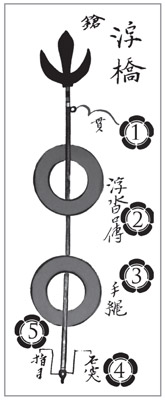
‘The Life Jacket’
1 Oral tradition
[‘Life jacket’ is the closest translation, however its literal translation would be ‘Floating Shoe’. It is mistakenly believed that the ‘Water-Spider’ ninja tool is a set of floating shoes, an idea spread by the late ninjutsu researcher, Fujita Seiko, as discussed earlier. It is here where Mr Seiko may have derived his ideas, as this is a similar tool. Both this tool and the latter are forms of inflatable flotation buoys that tie around the waist. The
Bansenshukai
manual states that these tools sometimes have ‘screw caps’ to aid inflation, which could be one of the secrets which are referenced in the manual as an oral tradition.]
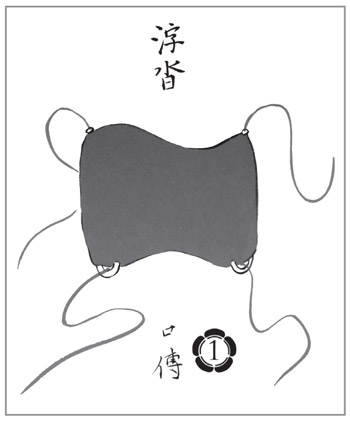
‘The Rapid Boat’
[There are no notes for this tool, not even a
Kuden
oral tradition mark. It is simply titled ‘Fast Ship’ or ‘Rapid Boat’. The
Bansenshukai
has a full description of one of these vessels. The
Bansenshukai
version of this craft is a selection of plates (not unlike the ones presented here) that fold away and can be used to construct the basic framework of a boat, which is then covered in a treated leather skin to form a waterproof hull. This version clearly has sections missing and no instructions on its construction. The hooks and metal brackets in the image appear to not match the plates next to each other. It is unknown if this is a ‘V’ shaped hull or a square-bottomed boat and if the thinner sections are bottom boards or not. The bow and stern construction is unknown and not illustrated and nor is the skin of the hull. Its use is understood but its construction is an oral tradition that has yet to be fathomed.]
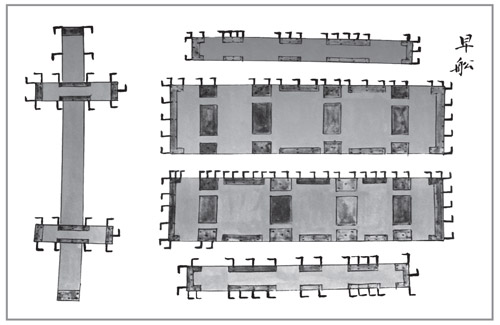
‘The Horseback Shield’
1 The length is two
Shaku
and eight
Sun
.
2 This window is a Monomi or scouting window.
3 The red arches here are wooden arm grips.
4 The cross here is made of rope.
5 The width of this shield is one
Shaku
and five
Sun.
6 There are more secrets here.
7 The two red strings at the bottom are hemp rope.

[The Horseback Shield appears to be a variation of the shield found in the
Gunpo Jiyoshu
manual, both have viewing ports. However, the difference here is that this version appears to be used by
Monomi
horseback scouts and is most likely use to ward off arrows when openly spying on the enemy, or when retreating after infiltrating the enemy territory.]
‘The Fire Boat’
1 This red line is the ‘Sending Fire’.
185
2 This is a rudder.
3 The large yellow section is the main hull.
4 This is also a rudder.
5 This section of the red line is also a ‘Sending Fire’.
186
[Fire craft have been used in the East right back to ancient China. This version has a few details that are unknown. Firstly, the size of the overall craft is not commented on. This could be a series of small boats or larger ‘ships’. This fuse or ‘sending fire’ appears to be lit on one side, so could be an explosive directional propellent. The craft appears to work on a twin-rudder system, however, it is not mentioned if these rudders are manned, that is if the ship is big enough, and if the said pilot abandons the ship at the last moment, or if these rudders are controlled by long ropes as the craft makes its way downstream and towards the target, or if they are fixed rudders used to help keep a straight course. The fire in the centre is made of ‘tied grass’ and in all probability is straw saturated with flammable oil. This may also be terminology for a hardened substance, which in fact contains no grass at all.
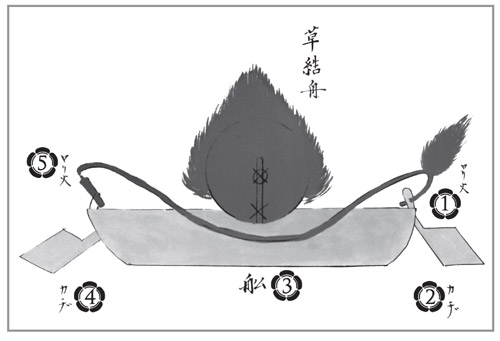
All in all, this is a very interesting device and fits well within the ninja ethos of the guerrilla tactician and explosives expert as well as with samurai naval warfare.]
‘The Broad Breath-Hiding Cloth’
1 Oral tradition
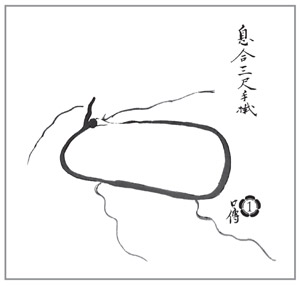
[This is a cover that hides the trace of warm breath hitting cool air and thus helps to hide a scout. The name itself literally translates as ‘Breath Meeting Thirty Centimetre Cloth (
Tenugui
). This was most likely used on a horse, as its construction appears to be designed as a muzzle. It appears that the 30cm cloth is rolled up lengthways with a knot placed in one end and in one corner of the cloth, as can be seen by the red nodule in the upper left corner of the image. The end of the cloth tapers off and is entwined with a black string that appears to secure to the ‘tied knot’ then the apparatus goes around the horse’s mouth and nose and is pulled tight, clamping the horse’s mouth closed. The four strings probably secure the cover to the horse’s bridle. A similar system is used by the
Otsubo hon
school and was mentioned earlier.
‘The Overhang Climbing Bridge’
1 This is a sickle and there are secrets here.
2 Jute rope
3 There are more oral traditions.
4 This is a sickle and there are secrets here.
5 The grapple is made of iron and has oral traditions attached to it.
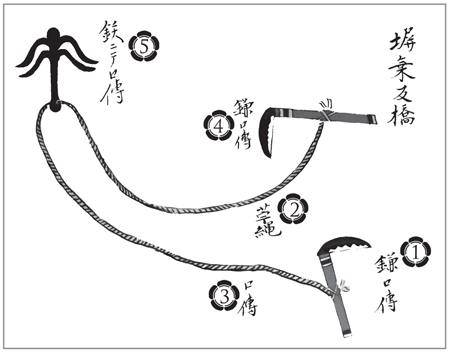
Of all the tools within this scroll, this is possibly the most difficult to interpret. When literally translated the tool becomes ‘The Reverse Wall Climbing Bridge’,
187
which leaves a selection of various functions. The tool itself is a grappling iron that allows a rope to pass through in two directions, a rope which has sickles attached to both ends. The
Shoninki
ninja manual talks about using a grappling iron and spikes to help ascend walls, which could mean that this tool is use in this way. The Japanese connotations in the title give the feel of a ‘rising curve’, going back over itself, therefore the primary meaning is something to with an ‘overhang’ when climbing outer castle walls, as the walls in question, within the title, are outer defensive walls and not those that support buildings. It is possible that a shinobi would grapple up on to the top of the wall and insert the sickles into the masonry below –under an overhang – which would give him a double rope ‘bridge’ to shimmy up. This would explain the reason for the tying of the rope to the hafts at the half way mark, as when used on an overhang any pressure on the haft from the rope at this angle would cause the sickle to jam against the roof of any crevice. To imagine this tool in use, you have to see an agent climbing face upwards towards an overhanging turret wall with his back resting on the two ropes below him or scuttling along face down.
An alternative usage would be to use the grapple in a standard way but with the addition of the infiltrating agent standing on the sickles, which have been inserted into holes in the stonework, using them to create a series of foot holds. He then uses the rope to pull on and free each sickle, shaking the lower sickle free to pull it up after him, ready to find a suitable hole for his next step, and so on to the top. This is a second possible reason as to why the ropes are tied in the middle of the sickle haft, helping the ninja rattle them free.
A third alternative would be that a shinobi could tie a loop in each rope, a short distance below both sickles. This way he could hold a sickle in each hand and hook them into a suitable hole and place his feet in the rope loops, transferring all his weight onto the two sickle points. He could then transfer all of his weight on to one side and move one sickle up as high as possible and then step up. In this example, the ninja would allow the grapple to hang below him and carry his equipment as he ascends, which could account for the ‘reverse’ element in the title. Lastly, it could be a version of the shinobi tool called the ‘Kuribashigo’ which is a grapple with two ropes. A shinobi would tie rungs onto the rope and climb up section by section.
